Scott Benson – Research Fishery Biologist, NOAA Fisheries – SWFSC – Marine Turtle Ecology and Assessment Program
Mammal Observer 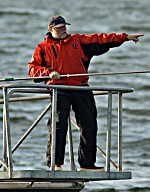 I’m a marine ecologist with over 20 years of at-sea research experience throughout the world’s oceans. Lead investigator of the leatherback turtle ecology program at NOAA’s Southwest Fisheries Science Center. Coordinate research on leatherbacks in central California and the Western Pacific. Education includes a B.A. from San Diego State University and an M.S. in Marine Science from Moss Landing Marine Laboratories. Research projects have included integrated studies of marine mammals, seabirds and leatherback turtles, with emphasis on abundance, distribution, ecology, and oceanographic patterns influencing the occurrence of these species. I’m a marine ecologist with over 20 years of at-sea research experience throughout the world’s oceans. Lead investigator of the leatherback turtle ecology program at NOAA’s Southwest Fisheries Science Center. Coordinate research on leatherbacks in central California and the Western Pacific. Education includes a B.A. from San Diego State University and an M.S. in Marine Science from Moss Landing Marine Laboratories. Research projects have included integrated studies of marine mammals, seabirds and leatherback turtles, with emphasis on abundance, distribution, ecology, and oceanographic patterns influencing the occurrence of these species.
|
Lori Beraha – Marine Naturalist, Monterey Bay National Marine Sanctuary
Mammal Observer 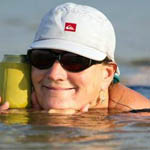 Lori has been working as a Marine Naturalist/Educator and Marine Mammal Observer for over 13 years in Monterey Bay, Hawaii, Alaska and South Africa. This will be her second trip to the Davidson Seamount and is hoping for good looks at some of the more elusive, deeper diving cetaceans and pelagic birds. In August she is headed to Fairbanks, Alaska to continue her graduate studies. Lori has been working as a Marine Naturalist/Educator and Marine Mammal Observer for over 13 years in Monterey Bay, Hawaii, Alaska and South Africa. This will be her second trip to the Davidson Seamount and is hoping for good looks at some of the more elusive, deeper diving cetaceans and pelagic birds. In August she is headed to Fairbanks, Alaska to continue her graduate studies.
What else? – Happiest when in or on the water, swimming, sailing, paddling. |
Abraham Borker – UC Santa Cruz
Seabird Observer 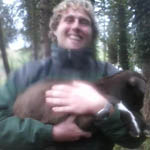 Abe Borker is most happy watching extreme seabirds carve up ocean winds like butter. His research on seabird colony soundscapes, just can’t match the whimsical aesthetic beauty of an arcing petrel over pounding swell. Time and again Abe is drawn by blue horizons and time at sea to observe seabirds in their element (and the hospitality of the Shimada is an added perk!). As a seabird and marine mammal observer for NOAA SWFSC and AMLR research programs, he’s a seasoned veteran, returning to the Davidson Seamount for a second time. Abe Borker is most happy watching extreme seabirds carve up ocean winds like butter. His research on seabird colony soundscapes, just can’t match the whimsical aesthetic beauty of an arcing petrel over pounding swell. Time and again Abe is drawn by blue horizons and time at sea to observe seabirds in their element (and the hospitality of the Shimada is an added perk!). As a seabird and marine mammal observer for NOAA SWFSC and AMLR research programs, he’s a seasoned veteran, returning to the Davidson Seamount for a second time.
What else? – Abe’s research on automated wildlife monitoring and bioacoustics will provide a constant source of questions and distraction for the hardworking marine bio-acousticians and UAV scientists on board. He likes coffee, and bicycles, but not plaid or artisan mayonnaise. |
Jim Brennan – Marine Biological Consultant
Fish Biologist  Jim has a Master of Science Degree in Marine Science from Moss Landing Marine Laboratories and 33 years of work experience. The majority of his work has focused on marine fisheries and habitats on the west coast of the U.S. (California, Oregon, Washington), but ranges from Antarctica to Alaska. Jim has worked in both the private and public sectors with responsibilities that include research, education, environmental assessment, watershed planning, restoration, regulatory, and policy programs. The last 24 years of his career have been spent working in Puget Sound on marine resource management issues with a focus on marine nearshore habitats and species. Jim has served on numerous technical assessment and advisory committees for federal, state, and local entities and as President of the Pacific Estuarine Research Society (PERS) and Governing Board Member of the Coastal and Estuarine Research Federation (CERF), an international science organization. Jim is currently self employed, providing technical assistance, education and outreach, and other marine consulting, restoration, and technical services. Jim has a Master of Science Degree in Marine Science from Moss Landing Marine Laboratories and 33 years of work experience. The majority of his work has focused on marine fisheries and habitats on the west coast of the U.S. (California, Oregon, Washington), but ranges from Antarctica to Alaska. Jim has worked in both the private and public sectors with responsibilities that include research, education, environmental assessment, watershed planning, restoration, regulatory, and policy programs. The last 24 years of his career have been spent working in Puget Sound on marine resource management issues with a focus on marine nearshore habitats and species. Jim has served on numerous technical assessment and advisory committees for federal, state, and local entities and as President of the Pacific Estuarine Research Society (PERS) and Governing Board Member of the Coastal and Estuarine Research Federation (CERF), an international science organization. Jim is currently self employed, providing technical assistance, education and outreach, and other marine consulting, restoration, and technical services.
|
Erica Burton – Research Specialist, Monterey Bay National Marine Sanctuary
Team Lead: Midwater Fishes Characterization  As a Research Specialist, Erica Burton is responsible for characterizing biological communities, characterizing historical shipwrecks, assessing impacts from vessel groundings, providing programmatic support to the Research Activity Panel and Sanctuary Currents Symposium, co-authoring peer-reviewed and technical publications, and maintaining research program web pages. Field activities include biological characterization of Davidson Seamount and Sur Ridge, characterization of the USS Macon and SS Montebello, and assessing impacts of a lost shipping container in the deep sea. Erica earned a Bachelor of Science in Marine Biology from California State University, Long Beach, and a Master of Science in Marine Science from Moss Landing Marine Laboratories. As a Research Specialist, Erica Burton is responsible for characterizing biological communities, characterizing historical shipwrecks, assessing impacts from vessel groundings, providing programmatic support to the Research Activity Panel and Sanctuary Currents Symposium, co-authoring peer-reviewed and technical publications, and maintaining research program web pages. Field activities include biological characterization of Davidson Seamount and Sur Ridge, characterization of the USS Macon and SS Montebello, and assessing impacts of a lost shipping container in the deep sea. Erica earned a Bachelor of Science in Marine Biology from California State University, Long Beach, and a Master of Science in Marine Science from Moss Landing Marine Laboratories.
|
David Cade – PhD Student, Stanford University
Team Lead: Hydrophone Surveys 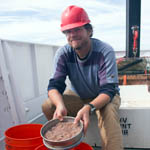 Dave started in the field of bioacoustics after spending 6 years teaching high school mathematics. The integration of trigonometry and biology has inspired him to pursue a PhD in biology at Stanford University. Dave started in the field of bioacoustics after spending 6 years teaching high school mathematics. The integration of trigonometry and biology has inspired him to pursue a PhD in biology at Stanford University.
What else? – In his free time, Dave tends to get as far from the ocean as possible up into the mountains. Recently he spent a month exploring Himalayan trails in Nepal. |
Greg Cailliet – Professor Emeritus, Moss Landing Marine Laboratories
Science Advisor 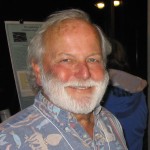 For more than four decades, I have studied marine fish ecology and been on the MLML faculty since 1972. I am primarily interested in deep-sea and chondrichthyan fishes. I have done field work and focused on their habitats and life histories (feeding habits, age and growth, reproduction, and demography) In the lab. My graduate students and I have pioneered age determination, verification, and validation techniques in fishes using the growth zones in calcified structures and their radioisotopic levels. Teaching & mentoring has been the most rewarding part of my career, having taught Marine Ichthyology, Population Biology, Ecology, Fisheries, and various graduate seminars. I have been the major advisor for 122 M.S. students, and on committees of numerous other M.S. and Ph.D. students. My students and colleagues are the reason for my productivity and any success I have achieved. For more than four decades, I have studied marine fish ecology and been on the MLML faculty since 1972. I am primarily interested in deep-sea and chondrichthyan fishes. I have done field work and focused on their habitats and life histories (feeding habits, age and growth, reproduction, and demography) In the lab. My graduate students and I have pioneered age determination, verification, and validation techniques in fishes using the growth zones in calcified structures and their radioisotopic levels. Teaching & mentoring has been the most rewarding part of my career, having taught Marine Ichthyology, Population Biology, Ecology, Fisheries, and various graduate seminars. I have been the major advisor for 122 M.S. students, and on committees of numerous other M.S. and Ph.D. students. My students and colleagues are the reason for my productivity and any success I have achieved.
What else? – I enjoy sailing, bicycling and traveling. |
Paul Chetirkin – Science Videographer, Office of National Marine Sanctuaries
Videographer  Paul Chetirkin helps to spread the National Marine Sanctuary Program message by producing outreach videos. As Multimedia Coordinator, he works with NMSP staff on a range of products highlighting the diverse work at the Sanctuary Program. Paul was born in San Francisco and has lived primarily in Florida and California. He earned a Bachelor’s Degree in History & Russian Studies from the University of Central Florida and a Master’s Degree in International Environmental Policy from the Monterey Institute of International Studies. His focus was on coral reef biodiversity studies and marine protected areas. Paul grew up tide pooling along Monterey Bay’s coast, volunteering at the Florida Keys Sanctuary, and diving for many years in the Monterey and Keys Sanctuaries. Prior to coming to the National Marine Sanctuary Program, Paul worked in non-profit for animal and environmental awareness. Paul Chetirkin helps to spread the National Marine Sanctuary Program message by producing outreach videos. As Multimedia Coordinator, he works with NMSP staff on a range of products highlighting the diverse work at the Sanctuary Program. Paul was born in San Francisco and has lived primarily in Florida and California. He earned a Bachelor’s Degree in History & Russian Studies from the University of Central Florida and a Master’s Degree in International Environmental Policy from the Monterey Institute of International Studies. His focus was on coral reef biodiversity studies and marine protected areas. Paul grew up tide pooling along Monterey Bay’s coast, volunteering at the Florida Keys Sanctuary, and diving for many years in the Monterey and Keys Sanctuaries. Prior to coming to the National Marine Sanctuary Program, Paul worked in non-profit for animal and environmental awareness.
|
Andrew DeVogelaere – Monterey Bay National Marine Sanctuary
Chief Scientist 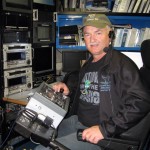 Dr. Andrew DeVogelaere oversees the Monterey Bay Sanctuary’s Research Program. His responsibilities include facilitating collaboration among over 20 research institutions in the region, providing technical information to decision makers and the Sanctuary staff, and initiating research on resource management issues.Andrew has been directly involved in a wide variety of research projects in habitats from the deep sea to estuaries. He earned a B.A. in Biology from the University of California at Berkeley, a M.S. in Marine Science from Moss Landing Marine Laboratories, and a Ph.D. in Biology from the University of California at Santa Cruz. Dr. Andrew DeVogelaere oversees the Monterey Bay Sanctuary’s Research Program. His responsibilities include facilitating collaboration among over 20 research institutions in the region, providing technical information to decision makers and the Sanctuary staff, and initiating research on resource management issues.Andrew has been directly involved in a wide variety of research projects in habitats from the deep sea to estuaries. He earned a B.A. in Biology from the University of California at Berkeley, a M.S. in Marine Science from Moss Landing Marine Laboratories, and a Ph.D. in Biology from the University of California at Santa Cruz.
What else? – Andrew enjoys beaches and the Sierra Nevada mountains with family and dogs, as well as sports photography. He’s and active supporter of St. Francis High School in Watsonville, Save The Earth, and the Santa Cruz County Animal Shelter. |
Ryan Fields – Graduate Student, Moss Landing Marine Laboratories
Fish Biologist  I am originally from Kodiak Island Alaska where I grew up commercial fishing for salmon each summer with my family. After receiving my B.S. in Chemistry at Westmont College, I worked for the National Marine Fisheries Service as a lab technician back in Kodiak, Alaska. Since 2012 I have been a graduate student in the Ichthyology lab at Moss Landing Marine Laboratories. My thesis project is investigating potential differences in life history traits between central and southern California populations of Rosy Rockfish (Sebastes rosaceus). I am passionate about the health of our oceans and I am excited to participate in this important research cruise at the Davidson Seamount. I am originally from Kodiak Island Alaska where I grew up commercial fishing for salmon each summer with my family. After receiving my B.S. in Chemistry at Westmont College, I worked for the National Marine Fisheries Service as a lab technician back in Kodiak, Alaska. Since 2012 I have been a graduate student in the Ichthyology lab at Moss Landing Marine Laboratories. My thesis project is investigating potential differences in life history traits between central and southern California populations of Rosy Rockfish (Sebastes rosaceus). I am passionate about the health of our oceans and I am excited to participate in this important research cruise at the Davidson Seamount.
What else? – I enjoy being outdoors and an spending time exploring tidepools. My hobbies include backpacking, hiking and nature photography. |
Chet Forest – Author/songwriter/producer, Retired Electrical Engineer
Sponsor 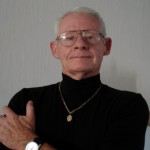 Chet is self-taught in Spanish, Sign Language and Braille and started serving in the Navy on the flight deck of an aircraft carrier, later transferring to a fast attack submarine, where developed a love and respect the ocean & has never quit being a voice to the public for the oceans. His adult career including working as a member of a top-secret missile launch crew putting spy satellites in orbit and an electric distribution engineer, a Chair of a City Planning Commission, on California’s Agricultural Commission, Advisor capacities for Non-Profit Foundations, Lectured at colleges on Marine Biology, Entomology, City Planning, Electrical Engineering, & Architectural site Concepts. An appointment to serve as a member of the Advisory Council of NOAA’s Monterey Bay National Marine Sanctuary, a position for which he has won awards Chet is self-taught in Spanish, Sign Language and Braille and started serving in the Navy on the flight deck of an aircraft carrier, later transferring to a fast attack submarine, where developed a love and respect the ocean & has never quit being a voice to the public for the oceans. His adult career including working as a member of a top-secret missile launch crew putting spy satellites in orbit and an electric distribution engineer, a Chair of a City Planning Commission, on California’s Agricultural Commission, Advisor capacities for Non-Profit Foundations, Lectured at colleges on Marine Biology, Entomology, City Planning, Electrical Engineering, & Architectural site Concepts. An appointment to serve as a member of the Advisory Council of NOAA’s Monterey Bay National Marine Sanctuary, a position for which he has won awards
What else? – Chet loves authoring books, writing songs (with over 50 copyrighted) and producing educational materials, with all sales profits being spread to various non-profit foundations. He also finds working on his ranch in Paso Robles very relaxing. |
John Garrett
Seabird Observer |
Scott Hamilton – Assistant Professor, Moss Landing Marine Laboratories
Science Advisor The Ichthyology lab at MLML studies the ecology of coastal marine fish, their role in nearshore ecosystems, and the response of these ecosystems to environmental change and human impacts. Using a combination of field experiments and observations, along with laboratory analyses, Dr. Hamilton’s lab focuses on research questions that range from early life stages of fish to whole ecosystems, including: (1) examination of early life history dynamics such as recruitment, selective mortality, and population linkages via larval dispersal; (2) investigation of the causes and consequences of demographic and life history variation among fish populations; and (3) evaluation of changes in the structure and function of fish communities associated with marine protection. The lab is motivated by a desire to provide fundamental insights to aid fisheries management and conservation efforts. |
Carol Keiper – Marine Observer, Oikonos Ecosystem Knowledge and Garcia and Associates
Mammal Observer  I have been involved in at-sea surveys on many ships for 16 years. I have served on Sanctuary Advisory Council for the CBNMS and received an Environmental Hero Award from NOAA I am founder and member of Oikonos Ecosystem Knowledge. I recently completed a project on vessel traffic risk assessment on the endangered Blue and Humpback whales off central California and was involved in the Joint Working Group for NOAA and changes in the shipping lanes became implemented in June 2013. I have also been working for Garcia and Associates as a marine mammal observer on the old Bay Bridge. I have been involved in at-sea surveys on many ships for 16 years. I have served on Sanctuary Advisory Council for the CBNMS and received an Environmental Hero Award from NOAA I am founder and member of Oikonos Ecosystem Knowledge. I recently completed a project on vessel traffic risk assessment on the endangered Blue and Humpback whales off central California and was involved in the Joint Working Group for NOAA and changes in the shipping lanes became implemented in June 2013. I have also been working for Garcia and Associates as a marine mammal observer on the old Bay Bridge.
What else? – I have been leading Natural History trips both in Baja California, Alaska, and central California in the Greater Farallones and Cordell Bank National Marine Sanctuaries for close to 25 years. My expertise and experience as a teacher, naturalist, scientist and avid sailor enhance my ability to share the wonders of the marine environment, and the value of conservation, with people of all ages! |
Aaron King – Marine Scientist, Retired
Fish Biologist 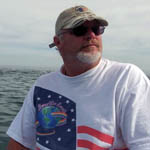 After graduating from UCSC and MLML, I worked for 25 years as a Marine Scientist, including time with the California Legislature, Congressional Committees, NMFS, the MBNMS, BLM, and the National MPA Center. Before retiring, I worked for five years helping recruit potential Peace Corps Volunteers, striving to get more marine scientists involved/recruited. After graduating from UCSC and MLML, I worked for 25 years as a Marine Scientist, including time with the California Legislature, Congressional Committees, NMFS, the MBNMS, BLM, and the National MPA Center. Before retiring, I worked for five years helping recruit potential Peace Corps Volunteers, striving to get more marine scientists involved/recruited.
What else? – My retirement plans include re-entering Peace Corps as a volunteer to serve a second tour. My first tour as a volunteer was in Ghana from 1981-83, where I taught biology and chemistry. Remember this – Peace Corps (and the countries it serves) has no upper age limit, and actively recruits older, wiser, and more experienced volunteer prospects. Visit “www.peacecorps.gov” for more information – “The toughest job you’ll ever love!” |
Chad King – Research Scientist, Monterey Bay National Marine Sanctuary
Team Lead: UAS Operations 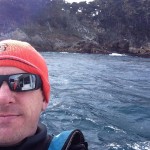 Chad has been with MBNMS since 2002 and manages spatial data for SIMoN. These data help integrate past and present monitoring programs within the Sanctuary, provide resource managers with decision making tools, and will be available to researchers, educators, students, and the general public. Chad actively participates in the field with Sanctuary and SIMoN research teamsfrom SCUBA diving up and down the Big Sur coast, to deep-sea research at the Davidson Seamount and Monterey Canyon and everything in between. Chad is an avid underwater photographer and videographer and has produced several documentaries, developed an iPhone app and a rich photo database for SIMoN. Chad has been with MBNMS since 2002 and manages spatial data for SIMoN. These data help integrate past and present monitoring programs within the Sanctuary, provide resource managers with decision making tools, and will be available to researchers, educators, students, and the general public. Chad actively participates in the field with Sanctuary and SIMoN research teamsfrom SCUBA diving up and down the Big Sur coast, to deep-sea research at the Davidson Seamount and Monterey Canyon and everything in between. Chad is an avid underwater photographer and videographer and has produced several documentaries, developed an iPhone app and a rich photo database for SIMoN.
What else? – Chad earned a B.S. in Marine Biology from UC Santa Cruz, and a M.S. degree in Marine Science from Moss Landing Marine Laboratories. He is married with two children and enjoys playing baseball, coaching softball, podcasting and covering games for the San Francisco Giants and enjoying quality time with his family. |
|
Robert Lea – Retired
Fish Biologist 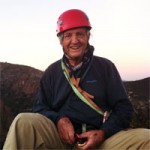 Dr. Lea was a marine biologist with California Department of Fish and Game for 37 years until his retirement. He received his Ph.D. from the University of Miami in 1980 and has numerous contributions on California and Eastern Pacific fishes. Bob has a distinguished and exhaustive list of publications to his credit, as well as many popular guide books, including co-author to “Guide to the Coastal Marine Fishes of California.” Dr. Lea was a marine biologist with California Department of Fish and Game for 37 years until his retirement. He received his Ph.D. from the University of Miami in 1980 and has numerous contributions on California and Eastern Pacific fishes. Bob has a distinguished and exhaustive list of publications to his credit, as well as many popular guide books, including co-author to “Guide to the Coastal Marine Fishes of California.”
What else? – Bob enjoys SCUBA exploration, mountaineering, hiking, travel and botany (including wine appreciation). |
Elizabeth Mackie – Vessel Operations Coordinator, NOAA, Channel Islands National Marine Sanctuary
UAS Pilot Elizabeth (Libby) Mackie, reported to CINMS for her assignment as Vessel Operations Coordinator in July 2014, and has assumed the role of Vessel Operations Coordinator, managing the Sanctuary’s 62′ R/V Shearwater and 28′ R/V Shark Cat. Libby came to us from her previous assignment as Junior Officer (Navigation, Safety, etc) aboard NOAA Ship Oscar Dyson, which primarily operates in Alaska, both the Bering Sea and the Gulf of Alaska. She is a NOAA diver and Divemaster with about 5 years of experience prior to her joining NOAA Corps in 2012. She also holds a 100 ton license. Prior to NOAA Corps, she was enlisted in the U.S. Navy in Hawaii, worked on dive boats. Later she attended College of the Atlantic and Maine Maritime Academy, both in Downeast Maine, during which time she was a NOAA Hollings Scholar. What else? – She loves diving, being outside, and spending time with her three dogs. |
Rebecca G. Martone – Ecosystem Health Program Lead, Center for Ocean Solutions
Team Lead: Environmental DNA 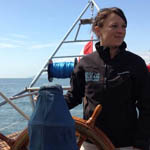 Rebecca works to integrate natural and social science with policy and management to inform solutions necessary for healthy and resilient coastal and marine ecosystems. As part of the MBON project, Rebecca will be working with the broader team to integrate data from different sources and help translate this into information that can support management needs. Her research focuses on human-caused changes to marine ecosystems, including nearshore rocky reef, kelp forest and pelagic ecosystems, and consequences for ecosystem services on which people depend. She has extensive experience managing large-scale, interdisciplinary teams working on real-world problems. Rebecca received a Ph.D. from Stanford University in biological sciences, a master’s degree from Duke University in marine environmental management and a bachelor’s degree from Northwestern University in environmental sciences. Rebecca works to integrate natural and social science with policy and management to inform solutions necessary for healthy and resilient coastal and marine ecosystems. As part of the MBON project, Rebecca will be working with the broader team to integrate data from different sources and help translate this into information that can support management needs. Her research focuses on human-caused changes to marine ecosystems, including nearshore rocky reef, kelp forest and pelagic ecosystems, and consequences for ecosystem services on which people depend. She has extensive experience managing large-scale, interdisciplinary teams working on real-world problems. Rebecca received a Ph.D. from Stanford University in biological sciences, a master’s degree from Duke University in marine environmental management and a bachelor’s degree from Northwestern University in environmental sciences.
What else? – Though born in Ohio, Rebecca has embraced the west coast lifestyle. She cherishes time on the water – sailing, paddleboarding, kayaking – and is a part-time naturalist for OuterShores Expeditions aboard the schooner Passing Cloud in coastal British Columbia. When not in her office, or on the water, she can be found hiking with her dog, Gus. |
Paul Michel – Superintendent, Monterey Bay National Marine Sanctuary
Videographer/Social Media  Paul Michel has 27 years of experience in environmental protection at the local, state, federal, and international levels. He is a nationally-recognized leader in wetlands, coast, and ocean management and protection. He has extensive experience in developing and implementing comprehensive natural resource management and protection plans and managing marine protected areas.Mr. Michel was named Superintendent of the Monterey Bay National Marine Sanctuary in April 2007. As Superintendent, he is responsible for all of the science, education, and resource protection programs involved with managing and protecting the nation’s second largest marine sanctuary at over 6,000 square miles. Mr. Michel also is Executive Co-Producer of YourSanctuaryTV, a local access cable and internet television show featuring national marine sanctuaries.Mr. Michel was born and raised in Oak Ridge, Tennessee. He earned a Bachelors degree from the University of Tennessee in political science and a Masters degree from Georgia State University in public administration. Paul Michel has 27 years of experience in environmental protection at the local, state, federal, and international levels. He is a nationally-recognized leader in wetlands, coast, and ocean management and protection. He has extensive experience in developing and implementing comprehensive natural resource management and protection plans and managing marine protected areas.Mr. Michel was named Superintendent of the Monterey Bay National Marine Sanctuary in April 2007. As Superintendent, he is responsible for all of the science, education, and resource protection programs involved with managing and protecting the nation’s second largest marine sanctuary at over 6,000 square miles. Mr. Michel also is Executive Co-Producer of YourSanctuaryTV, a local access cable and internet television show featuring national marine sanctuaries.Mr. Michel was born and raised in Oak Ridge, Tennessee. He earned a Bachelors degree from the University of Tennessee in political science and a Masters degree from Georgia State University in public administration.
|
Kelly Newton – Associate Research Specialist, UC Santa Cruz
Team Lead: Bird and Mammal Characterization 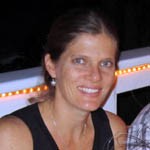 Kelly is an Associate Research Specialist at UC Santa Cruz and works in the Coastal Conservation Action Lab with Drs. Don Croll and Bernie Tershy. Kelly was onboard the Sanctuary’s first visit to the Davidson Seamount in 2002 and was the Chief Scientist on the Marine Mammal and Seabird Observation cruise to the Davidson Seamount in July 2010. At UC Santa Cruz, Kelly coordinated the Wind to Whales program, monitoring the abundance and distribution of marine mammals and seabirds within Monterey Bay. Kelly’s current research focus is on the integration of multiple long-term monitoring datasets to assess the impacts of invasive species eradications on islands. Kelly is an Associate Research Specialist at UC Santa Cruz and works in the Coastal Conservation Action Lab with Drs. Don Croll and Bernie Tershy. Kelly was onboard the Sanctuary’s first visit to the Davidson Seamount in 2002 and was the Chief Scientist on the Marine Mammal and Seabird Observation cruise to the Davidson Seamount in July 2010. At UC Santa Cruz, Kelly coordinated the Wind to Whales program, monitoring the abundance and distribution of marine mammals and seabirds within Monterey Bay. Kelly’s current research focus is on the integration of multiple long-term monitoring datasets to assess the impacts of invasive species eradications on islands.
What else? – Kelly enjoys mountain biking, surfing, and cooking |
|
Neal Pargman – Founder, Save the Earth Foundation
Sponsor 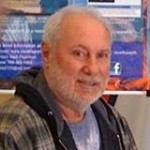 The objectives of Save the Earth Foundation include: To fund environmental research projects; To provide factual and educational information to the public about issues relating to the environment; To raise the level of environmental consciousness.Since 1989 Save the Earth Foundation has granted research funding to numerous colleges, universities, and MBNMS. Today more than ever we must acknowledge the fact that a great many environmental violations of the past continue to haunt us in the present. Our support of environmental research and education will continue to find solutions to these numerous man-made problems, and together we will help reverse the deterioration of our planet. The objectives of Save the Earth Foundation include: To fund environmental research projects; To provide factual and educational information to the public about issues relating to the environment; To raise the level of environmental consciousness.Since 1989 Save the Earth Foundation has granted research funding to numerous colleges, universities, and MBNMS. Today more than ever we must acknowledge the fact that a great many environmental violations of the past continue to haunt us in the present. Our support of environmental research and education will continue to find solutions to these numerous man-made problems, and together we will help reverse the deterioration of our planet.
|
Catarina Pien – Student/Museum Assistant, Moss Landing Marine Laboratories
Fish Biologist 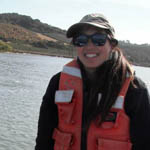 Hi! I’m Catarina, a masters student at Moss Landing Marine Laboratories. I grew up in New Jersey, and moved to California for graduate school. I am part of the Pacific Shark Research Center, and for my thesis I am studying elasmobranchs (sharks and rays) in Elkhorn Slough, and how their populations have changed over time. I also work at the lab’s museum, updating/ cataloging our inventory of specimens. I am currently photographing our marine mammal skeletal collection so that specimens can be viewed online. Hopefully we will collect some new/ interesting specimens on this cruise for our museum! Hi! I’m Catarina, a masters student at Moss Landing Marine Laboratories. I grew up in New Jersey, and moved to California for graduate school. I am part of the Pacific Shark Research Center, and for my thesis I am studying elasmobranchs (sharks and rays) in Elkhorn Slough, and how their populations have changed over time. I also work at the lab’s museum, updating/ cataloging our inventory of specimens. I am currently photographing our marine mammal skeletal collection so that specimens can be viewed online. Hopefully we will collect some new/ interesting specimens on this cruise for our museum!
What else? – My hobbies include rock climbing, sailing, paddleboarding, kayaking, and searching for pretty places to walk around. I also enjoy traveling and eating, and binge-watching TV. |
Jesse Port – Science Fellow, Center for Ocean Solutions (Stanford)
Geneticist 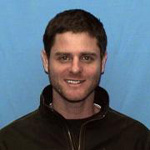 Jesse manages the environmental DNA (eDNA) project at the Center for Ocean Solutions. His research aims to develop genetic technologies that can be used to improve environmental monitoring of biodiversity and species presence. He is particularly interested in tracking marine fishes and mammals. In the field his team collects seawater samples alongside traditional monitoring methods (e.g. visual dive surveys, trawls) in order to ground-truth the eDNA data obtained from next generation sequencing. In addition to sampling at sea, the eDNA team also works in nearshore kelp forest ecosystems in Monterey Bay. Jesse received a PhD in Environmental Health and Toxicology from the University of Washington, where he used genomics to survey bacterial communities in Puget Sound for antibiotic resistance genes. Jesse manages the environmental DNA (eDNA) project at the Center for Ocean Solutions. His research aims to develop genetic technologies that can be used to improve environmental monitoring of biodiversity and species presence. He is particularly interested in tracking marine fishes and mammals. In the field his team collects seawater samples alongside traditional monitoring methods (e.g. visual dive surveys, trawls) in order to ground-truth the eDNA data obtained from next generation sequencing. In addition to sampling at sea, the eDNA team also works in nearshore kelp forest ecosystems in Monterey Bay. Jesse received a PhD in Environmental Health and Toxicology from the University of Washington, where he used genomics to survey bacterial communities in Puget Sound for antibiotic resistance genes.
|
Mark Rogers – Lead UAS Technical Rep, NOAA/AOC
UAS Pilot in Command NOAA Aircraft Operations Center UAS Technical Representative and Pilot
|
|
Kylie Scales – Postdoctoral Research Scholar, UC Santa Cruz, Institute of Marine Sciences
Team Lead: Oceanography 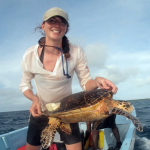 I am a marine ecologist and biological oceanographer, specialising in marine vertebrate spatial ecology. I am particularly interested in the biophysical mechanisms that underlie foraging habitat selection by wide-ranging marine predators such as seabirds, sea turtles, sharks, cetaceans and pinnipeds. My research integrates bio-telemetry, satellite remote sensing, in-situ survey data and habitat modelling techniques to improve understanding of how oceanographic processes influence marine predator space use. I have recently completed my doctorate at Plymouth Marine Laboratory, UK and am now a postdoctoral research scholar with the Cooperative Institute for Marine Ecosystems and Climate (CIMEC; UC Santa Cruz), based at the Environmental Research Division, NOAA Southwest Fisheries Science Center in Monterey, California. I am a marine ecologist and biological oceanographer, specialising in marine vertebrate spatial ecology. I am particularly interested in the biophysical mechanisms that underlie foraging habitat selection by wide-ranging marine predators such as seabirds, sea turtles, sharks, cetaceans and pinnipeds. My research integrates bio-telemetry, satellite remote sensing, in-situ survey data and habitat modelling techniques to improve understanding of how oceanographic processes influence marine predator space use. I have recently completed my doctorate at Plymouth Marine Laboratory, UK and am now a postdoctoral research scholar with the Cooperative Institute for Marine Ecosystems and Climate (CIMEC; UC Santa Cruz), based at the Environmental Research Division, NOAA Southwest Fisheries Science Center in Monterey, California.
|
Adam Searcy – Biologist, Western Foundation of Vertebrate Zoology
Mammal Observer 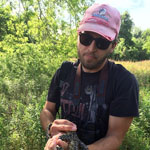 Adam is a field biologist specializing in ornithological survey work and the field identification of birds. He works as an independent consultant and an assistant at the WFVZ. Other work and interests include, botany, herpetology, and photography. He has worked on eight islands off of California’s coast and spent many days at sea studying pelagic birds and marine mammals. Adam also aims to create and consume the world’s most diverse meal (in the form of a burrito). Thus far, 132 and 150+ taxa have been consumed in two different taxonomic extravaganzas. He also likes to count creosote and will be collecting (negative?) data while surveying over the Davidson Seamount. Adam is a field biologist specializing in ornithological survey work and the field identification of birds. He works as an independent consultant and an assistant at the WFVZ. Other work and interests include, botany, herpetology, and photography. He has worked on eight islands off of California’s coast and spent many days at sea studying pelagic birds and marine mammals. Adam also aims to create and consume the world’s most diverse meal (in the form of a burrito). Thus far, 132 and 150+ taxa have been consumed in two different taxonomic extravaganzas. He also likes to count creosote and will be collecting (negative?) data while surveying over the Davidson Seamount.
|
Dena Spatz – PhD Student, UC Santa Cruz
Mammal Observer 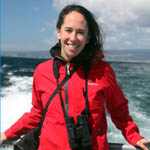 I am a PhD student in the Ecology and Evolutionary Biology Department at the University of California, Santa Cruz. My background is in avian ecology with a focus in seabird biography and conservation. My current research investigates the distribution and abundance of threatened seabirds on islands and the threats, such as invasive species, to seabird survival. I then use this information to prioritize conservation efforts that can protect the most threatened seabird populations from extinction. Previous to this, I worked on shipboard surveys of seabirds and marine mammals and on avian monitoring projects that investigated the impacts of contaminants and predation by native and non-native species on nesting success. I am a PhD student in the Ecology and Evolutionary Biology Department at the University of California, Santa Cruz. My background is in avian ecology with a focus in seabird biography and conservation. My current research investigates the distribution and abundance of threatened seabirds on islands and the threats, such as invasive species, to seabird survival. I then use this information to prioritize conservation efforts that can protect the most threatened seabird populations from extinction. Previous to this, I worked on shipboard surveys of seabirds and marine mammals and on avian monitoring projects that investigated the impacts of contaminants and predation by native and non-native species on nesting success.
|
Jessica Taatjes – COAST VISTA, CSU COAST
Oceanographer; Fish Biologist  I recently received a B.S. in Oceanography from Humboldt State University where I conducted undergraduate research on energy content of zooplankton off the coast of Trinidad, CA and Newport, OR. I have over 90 hours at sea conducting research which is the best part of my educational background. I am currently an AmeriCorps VISTA with CSU COAST while deciding on graduate school. While I am still involved in marine sciences, I am on the student engagement side so when I got this opportunity to volunteer with NOAA National Marine Sanctuaries I was very excited to get back out to sea. I recently received a B.S. in Oceanography from Humboldt State University where I conducted undergraduate research on energy content of zooplankton off the coast of Trinidad, CA and Newport, OR. I have over 90 hours at sea conducting research which is the best part of my educational background. I am currently an AmeriCorps VISTA with CSU COAST while deciding on graduate school. While I am still involved in marine sciences, I am on the student engagement side so when I got this opportunity to volunteer with NOAA National Marine Sanctuaries I was very excited to get back out to sea.
|
 I’m a marine ecologist with over 20 years of at-sea research experience throughout the world’s oceans. Lead investigator of the leatherback turtle ecology program at NOAA’s Southwest Fisheries Science Center. Coordinate research on leatherbacks in central California and the Western Pacific. Education includes a B.A. from San Diego State University and an M.S. in Marine Science from Moss Landing Marine Laboratories. Research projects have included integrated studies of marine mammals, seabirds and leatherback turtles, with emphasis on abundance, distribution, ecology, and oceanographic patterns influencing the occurrence of these species.
I’m a marine ecologist with over 20 years of at-sea research experience throughout the world’s oceans. Lead investigator of the leatherback turtle ecology program at NOAA’s Southwest Fisheries Science Center. Coordinate research on leatherbacks in central California and the Western Pacific. Education includes a B.A. from San Diego State University and an M.S. in Marine Science from Moss Landing Marine Laboratories. Research projects have included integrated studies of marine mammals, seabirds and leatherback turtles, with emphasis on abundance, distribution, ecology, and oceanographic patterns influencing the occurrence of these species. Lori has been working as a Marine Naturalist/Educator and Marine Mammal Observer for over 13 years in Monterey Bay, Hawaii, Alaska and South Africa. This will be her second trip to the Davidson Seamount and is hoping for good looks at some of the more elusive, deeper diving cetaceans and pelagic birds. In August she is headed to Fairbanks, Alaska to continue her graduate studies.
Lori has been working as a Marine Naturalist/Educator and Marine Mammal Observer for over 13 years in Monterey Bay, Hawaii, Alaska and South Africa. This will be her second trip to the Davidson Seamount and is hoping for good looks at some of the more elusive, deeper diving cetaceans and pelagic birds. In August she is headed to Fairbanks, Alaska to continue her graduate studies.


 Dave started in the field of bioacoustics after spending 6 years teaching high school mathematics. The integration of trigonometry and biology has inspired him to pursue a PhD in biology at Stanford University.
Dave started in the field of bioacoustics after spending 6 years teaching high school mathematics. The integration of trigonometry and biology has inspired him to pursue a PhD in biology at Stanford University.






 Chad has been with MBNMS since 2002 and manages spatial data for
Chad has been with MBNMS since 2002 and manages spatial data for  Dr. Lea was a marine biologist with California Department of Fish and Game for 37 years until his retirement. He received his Ph.D. from the University of Miami in 1980 and has numerous contributions on California and Eastern Pacific fishes. Bob has a distinguished and exhaustive list of publications to his credit, as well as many popular guide books, including co-author to “Guide to the Coastal Marine Fishes of California.”
Dr. Lea was a marine biologist with California Department of Fish and Game for 37 years until his retirement. He received his Ph.D. from the University of Miami in 1980 and has numerous contributions on California and Eastern Pacific fishes. Bob has a distinguished and exhaustive list of publications to his credit, as well as many popular guide books, including co-author to “Guide to the Coastal Marine Fishes of California.” Rebecca works to integrate natural and social science with policy and management to inform solutions necessary for healthy and resilient coastal and marine ecosystems. As part of the MBON project, Rebecca will be working with the broader team to integrate data from different sources and help translate this into information that can support management needs. Her research focuses on human-caused changes to marine ecosystems, including nearshore rocky reef, kelp forest and pelagic ecosystems, and consequences for ecosystem services on which people depend. She has extensive experience managing large-scale, interdisciplinary teams working on real-world problems. Rebecca received a Ph.D. from Stanford University in biological sciences, a master’s degree from Duke University in marine environmental management and a bachelor’s degree from Northwestern University in environmental sciences.
Rebecca works to integrate natural and social science with policy and management to inform solutions necessary for healthy and resilient coastal and marine ecosystems. As part of the MBON project, Rebecca will be working with the broader team to integrate data from different sources and help translate this into information that can support management needs. Her research focuses on human-caused changes to marine ecosystems, including nearshore rocky reef, kelp forest and pelagic ecosystems, and consequences for ecosystem services on which people depend. She has extensive experience managing large-scale, interdisciplinary teams working on real-world problems. Rebecca received a Ph.D. from Stanford University in biological sciences, a master’s degree from Duke University in marine environmental management and a bachelor’s degree from Northwestern University in environmental sciences. Paul Michel has 27 years of experience in environmental protection at the local, state, federal, and international levels. He is a nationally-recognized leader in wetlands, coast, and ocean management and protection. He has extensive experience in developing and implementing comprehensive natural resource management and protection plans and managing marine protected areas.Mr. Michel was named Superintendent of the Monterey Bay National Marine Sanctuary in April 2007. As Superintendent, he is responsible for all of the science, education, and resource protection programs involved with managing and protecting the nation’s second largest marine sanctuary at over 6,000 square miles. Mr. Michel also is Executive Co-Producer of
Paul Michel has 27 years of experience in environmental protection at the local, state, federal, and international levels. He is a nationally-recognized leader in wetlands, coast, and ocean management and protection. He has extensive experience in developing and implementing comprehensive natural resource management and protection plans and managing marine protected areas.Mr. Michel was named Superintendent of the Monterey Bay National Marine Sanctuary in April 2007. As Superintendent, he is responsible for all of the science, education, and resource protection programs involved with managing and protecting the nation’s second largest marine sanctuary at over 6,000 square miles. Mr. Michel also is Executive Co-Producer of  Kelly is an Associate Research Specialist at UC Santa Cruz and works in the Coastal Conservation Action Lab with Drs. Don Croll and Bernie Tershy. Kelly was onboard the Sanctuary’s first visit to the Davidson Seamount in 2002 and was the Chief Scientist on the Marine Mammal and Seabird Observation cruise to the Davidson Seamount in July 2010. At UC Santa Cruz, Kelly coordinated the Wind to Whales program, monitoring the abundance and distribution of marine mammals and seabirds within Monterey Bay. Kelly’s current research focus is on the integration of multiple long-term monitoring datasets to assess the impacts of invasive species eradications on islands.
Kelly is an Associate Research Specialist at UC Santa Cruz and works in the Coastal Conservation Action Lab with Drs. Don Croll and Bernie Tershy. Kelly was onboard the Sanctuary’s first visit to the Davidson Seamount in 2002 and was the Chief Scientist on the Marine Mammal and Seabird Observation cruise to the Davidson Seamount in July 2010. At UC Santa Cruz, Kelly coordinated the Wind to Whales program, monitoring the abundance and distribution of marine mammals and seabirds within Monterey Bay. Kelly’s current research focus is on the integration of multiple long-term monitoring datasets to assess the impacts of invasive species eradications on islands. The objectives of Save the Earth Foundation include: To fund environmental research projects; To provide factual and educational information to the public about issues relating to the environment; To raise the level of environmental consciousness.Since 1989 Save the Earth Foundation has granted research funding to numerous colleges, universities, and MBNMS. Today more than ever we must acknowledge the fact that a great many environmental violations of the past continue to haunt us in the present. Our support of environmental research and education will continue to find solutions to these numerous man-made problems, and together we will help reverse the deterioration of our planet.
The objectives of Save the Earth Foundation include: To fund environmental research projects; To provide factual and educational information to the public about issues relating to the environment; To raise the level of environmental consciousness.Since 1989 Save the Earth Foundation has granted research funding to numerous colleges, universities, and MBNMS. Today more than ever we must acknowledge the fact that a great many environmental violations of the past continue to haunt us in the present. Our support of environmental research and education will continue to find solutions to these numerous man-made problems, and together we will help reverse the deterioration of our planet.
 Jesse manages the environmental DNA (eDNA) project at the Center for Ocean Solutions. His research aims to develop genetic technologies that can be used to improve environmental monitoring of biodiversity and species presence. He is particularly interested in tracking marine fishes and mammals. In the field his team collects seawater samples alongside traditional monitoring methods (e.g. visual dive surveys, trawls) in order to ground-truth the eDNA data obtained from next generation sequencing. In addition to sampling at sea, the eDNA team also works in nearshore kelp forest ecosystems in Monterey Bay. Jesse received a PhD in Environmental Health and Toxicology from the University of Washington, where he used genomics to survey bacterial communities in Puget Sound for antibiotic resistance genes.
Jesse manages the environmental DNA (eDNA) project at the Center for Ocean Solutions. His research aims to develop genetic technologies that can be used to improve environmental monitoring of biodiversity and species presence. He is particularly interested in tracking marine fishes and mammals. In the field his team collects seawater samples alongside traditional monitoring methods (e.g. visual dive surveys, trawls) in order to ground-truth the eDNA data obtained from next generation sequencing. In addition to sampling at sea, the eDNA team also works in nearshore kelp forest ecosystems in Monterey Bay. Jesse received a PhD in Environmental Health and Toxicology from the University of Washington, where he used genomics to survey bacterial communities in Puget Sound for antibiotic resistance genes.  I am a marine ecologist and biological oceanographer, specialising in marine vertebrate spatial ecology. I am particularly interested in the biophysical mechanisms that underlie foraging habitat selection by wide-ranging marine predators such as seabirds, sea turtles, sharks, cetaceans and pinnipeds. My research integrates bio-telemetry, satellite remote sensing, in-situ survey data and habitat modelling techniques to improve understanding of how oceanographic processes influence marine predator space use. I have recently completed my doctorate at Plymouth Marine Laboratory, UK and am now a postdoctoral research scholar with the Cooperative Institute for Marine Ecosystems and Climate (CIMEC; UC Santa Cruz), based at the Environmental Research Division, NOAA Southwest Fisheries Science Center in Monterey, California.
I am a marine ecologist and biological oceanographer, specialising in marine vertebrate spatial ecology. I am particularly interested in the biophysical mechanisms that underlie foraging habitat selection by wide-ranging marine predators such as seabirds, sea turtles, sharks, cetaceans and pinnipeds. My research integrates bio-telemetry, satellite remote sensing, in-situ survey data and habitat modelling techniques to improve understanding of how oceanographic processes influence marine predator space use. I have recently completed my doctorate at Plymouth Marine Laboratory, UK and am now a postdoctoral research scholar with the Cooperative Institute for Marine Ecosystems and Climate (CIMEC; UC Santa Cruz), based at the Environmental Research Division, NOAA Southwest Fisheries Science Center in Monterey, California. Adam is a field biologist specializing in ornithological survey work and the field identification of birds. He works as an independent consultant and an assistant at the WFVZ. Other work and interests include, botany, herpetology, and photography. He has worked on eight islands off of California’s coast and spent many days at sea studying pelagic birds and marine mammals. Adam also aims to create and consume the world’s most diverse meal (in the form of a burrito). Thus far, 132 and 150+ taxa have been consumed in two different taxonomic extravaganzas. He also likes to count creosote and will be collecting (negative?) data while surveying over the Davidson Seamount.
Adam is a field biologist specializing in ornithological survey work and the field identification of birds. He works as an independent consultant and an assistant at the WFVZ. Other work and interests include, botany, herpetology, and photography. He has worked on eight islands off of California’s coast and spent many days at sea studying pelagic birds and marine mammals. Adam also aims to create and consume the world’s most diverse meal (in the form of a burrito). Thus far, 132 and 150+ taxa have been consumed in two different taxonomic extravaganzas. He also likes to count creosote and will be collecting (negative?) data while surveying over the Davidson Seamount.  I am a PhD student in the Ecology and Evolutionary Biology Department at the University of California, Santa Cruz. My background is in avian ecology with a focus in seabird biography and conservation. My current research investigates the distribution and abundance of threatened seabirds on islands and the threats, such as invasive species, to seabird survival. I then use this information to prioritize conservation efforts that can protect the most threatened seabird populations from extinction. Previous to this, I worked on shipboard surveys of seabirds and marine mammals and on avian monitoring projects that investigated the impacts of contaminants and predation by native and non-native species on nesting success.
I am a PhD student in the Ecology and Evolutionary Biology Department at the University of California, Santa Cruz. My background is in avian ecology with a focus in seabird biography and conservation. My current research investigates the distribution and abundance of threatened seabirds on islands and the threats, such as invasive species, to seabird survival. I then use this information to prioritize conservation efforts that can protect the most threatened seabird populations from extinction. Previous to this, I worked on shipboard surveys of seabirds and marine mammals and on avian monitoring projects that investigated the impacts of contaminants and predation by native and non-native species on nesting success. I recently received a B.S. in Oceanography from Humboldt State University where I conducted undergraduate research on energy content of zooplankton off the coast of Trinidad, CA and Newport, OR. I have over 90 hours at sea conducting research which is the best part of my educational background. I am currently an AmeriCorps VISTA with CSU COAST while deciding on graduate school. While I am still involved in marine sciences, I am on the student engagement side so when I got this opportunity to volunteer with NOAA National Marine Sanctuaries I was very excited to get back out to sea.
I recently received a B.S. in Oceanography from Humboldt State University where I conducted undergraduate research on energy content of zooplankton off the coast of Trinidad, CA and Newport, OR. I have over 90 hours at sea conducting research which is the best part of my educational background. I am currently an AmeriCorps VISTA with CSU COAST while deciding on graduate school. While I am still involved in marine sciences, I am on the student engagement side so when I got this opportunity to volunteer with NOAA National Marine Sanctuaries I was very excited to get back out to sea.